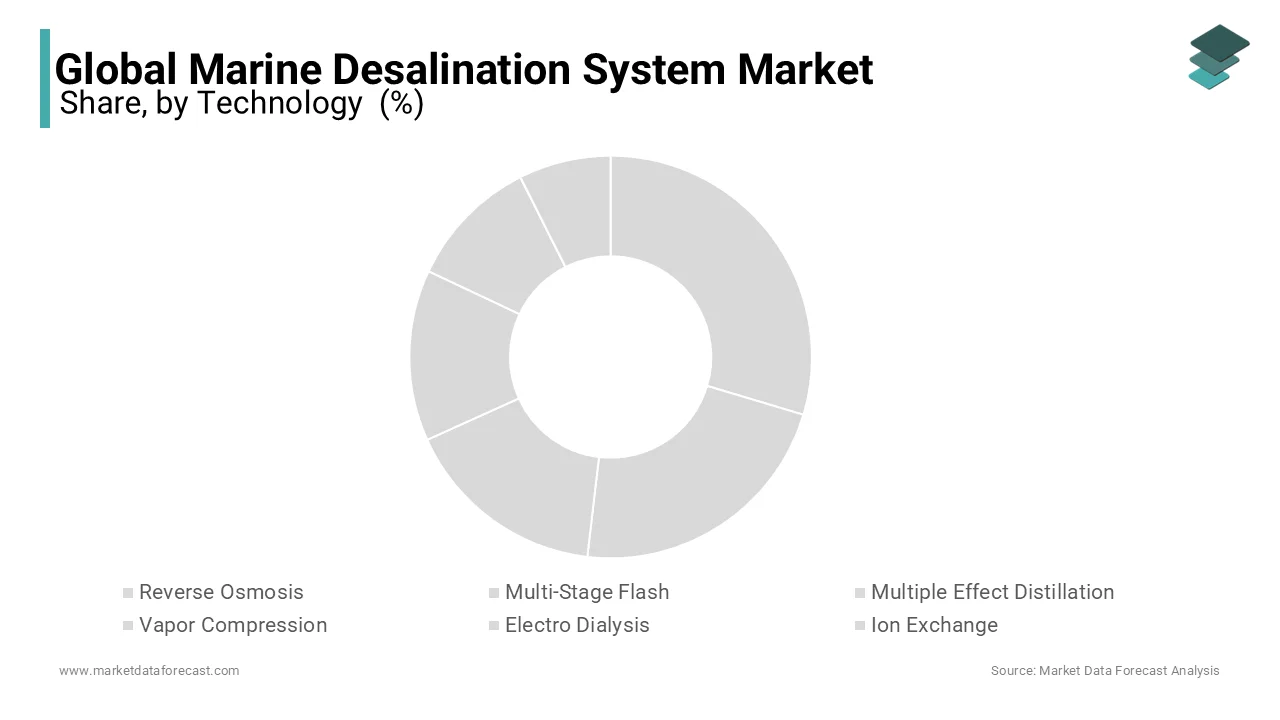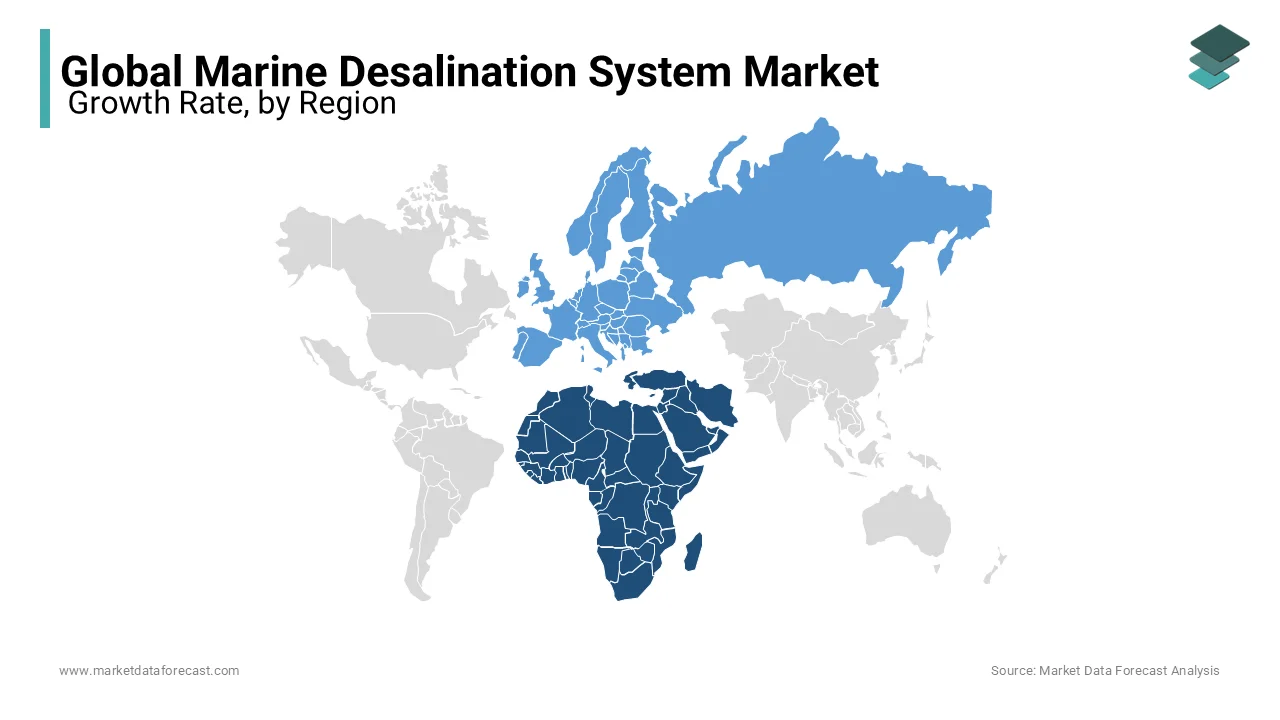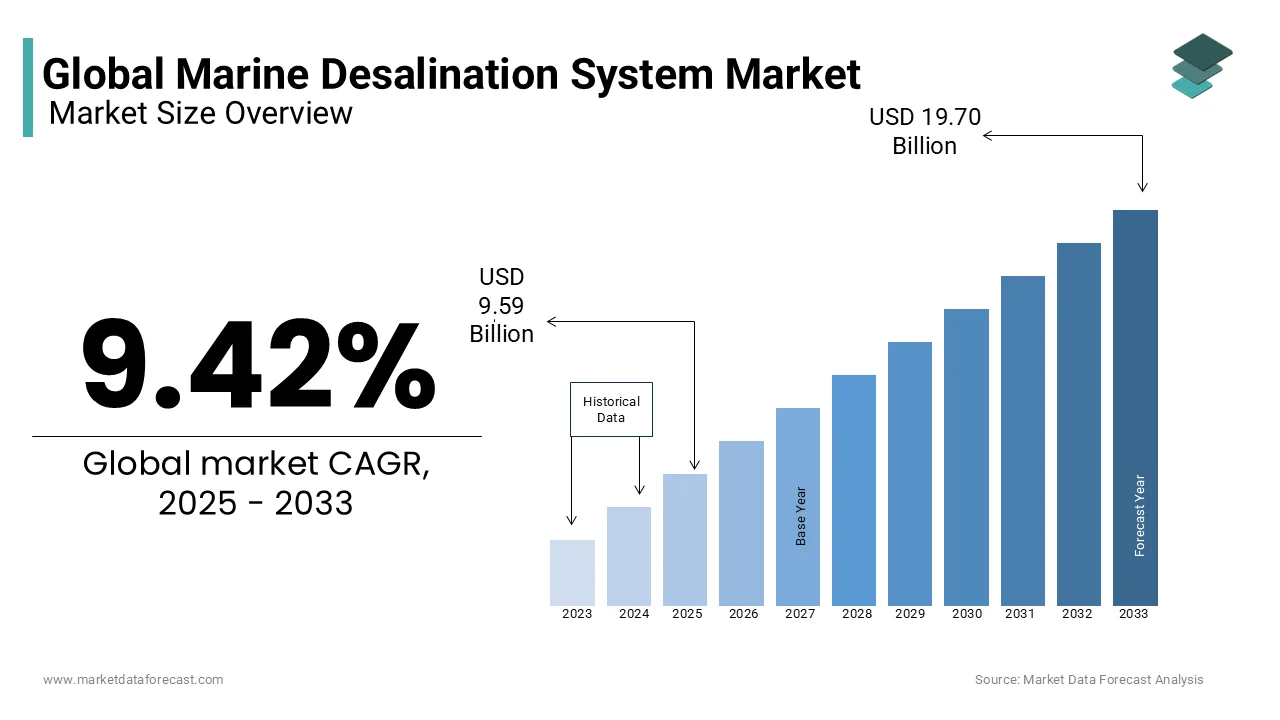Global Marine Desalination System Market Size, Share, Trends, & Growth Forecast Report By Technology (Reverse Osmosis, Multi-Stage Flash, Multiple Effect Distillation, Vapor Compression, Electro Dialysis, Ion Exchange and Others), Application (Municipal, Industrial, Hospitality, Military and Others) & Region, Industry Forecast From 2024 to 2033
Global Marine Desalination System Market Size
The Global Marine Desalination System Market was worth USD 8.76 billion in 2024 and is anticipated to reach a valuation of USD 19.70 billion by 2033 from 9.59 billion in 2025 and is predicted to register a CAGR of 9.42% during 2025-2033.
Marine waters, known as sea or ocean waters with saltwater, cover approximately 71% of the Earth's surface. 96% of the Earth's water is salty water with an average salinity of 3% to 3.5%. Freshwater sources are unevenly distributed across the planet, making seawater an alternative source in various regions. However, it is not possible to use seawater directly for drinking and agricultural purposes due to its salinity. The call for freshwater has increased due to population expansion and urbanization. Thus, a series of processes or systems are implemented depending on the available resources to satisfy the call for fresh water. The marine desalination system is one of them. The system is mainly implemented when the area is close to the sea coast or on ships or submarines. Desalination removes salts and mineral compounds from saline water. Seawater is desalinated to produce water suitable for human consumption or agriculture. Desalination is an energy-intensive process that takes a lot of energy to break the water and salt bonds. Also, renewable energy sources are employed as preferable energy sources to reduce energy impact on the environment, local communities, and the economy for the desalination process. The marine desalination system is one of the main sources of drinking water when the area is very close to the sea. The marine desalination system plays a critical role in ships and submarines in providing drinking water in the middle of the ocean. Seawater Desalination Vessel (SDV) technology is employed on merchant ships to generate freshwater to meet the usual needs of the crew.
MARKET TRENDS
Reverse osmosis is a widely employed method for the desalination of seawater and brackish seawater. The segment accounted for a significant part of the worldwide market in 2018. In the reverse osmosis separation technique, water passes under high pressure from the concentrated side to the diluted side through a semi-membrane. permeable that retains solutes such as salts, unwanted materials, etc. Reverse osmosis can be employed for a wide range of applications such as ultrapure water, boiler feed water, and wastewater treatment, including desalination of seawater, and brackish water is an important application.
MARKET DRIVERS
The reuse of water in the marine industry has become an important part of the world's water resources management, driving calls for marine desalination systems. Manufacturers are embracing traditional technologies that are energy efficient, and easily replace old installations, which is the market engine for marine desalination systems. Also, emerging economies are focusing more on efficient technologies to reduce the problem of water scarcity in regions where decreased rainfall is a critical problem. Therefore, reducing the cost of capital and improving the operating cost of desalination drives market expansion. Water resources management focuses more on the reuse of water in the maritime industry, as it is one of the important factors driving the worldwide call for seawater desalination systems.
MARKET RESTRAINTS
The market for marine desalination systems is concentrated because the technology to manufacture seawater desalination systems is relatively expensive. A considerable amount of CO2 is generated during the desalination process of seawater, escalating the carbon footprint, which is likely to hamper the market boom.
MARKET OPPORTUNITIES
The global marine seawater desalination system has employed reverse osmosis methods that are widely employed in the desalination of brackish marine seawater. In this method, the pressure is built to pass the water through a semi-permeable membrane from the concentrated side to the diluted side, this water goes through the high pressure and retains the solute as unwanted materials and salts, etc. This water is employed in various applications, among which the desalination of seawater and brackish water stands out. Other applications such as ultrapure water, boiler feedwater, and wastewater treatment are driving the market for marine desalination systems.
MARKET CHALLENGES
The effect of removing the brine or desalination concentrate is considered a major environmental concern. The concentration of brine varies considerably in each geographic area depending on the nature of the concentrate, the degree of dilution, and the surrounding aquatic biota. Strict maritime regulations regarding desalted brine discharge are predicted to hamper the market during the foreseen period.
REPORT COVERAGE
|
REPORT METRIC |
DETAILS |
|
Market Size Available |
2024 to 2033 |
|
Base Year |
2024 |
|
Forecast Period |
2025 to 2033 |
|
CAGR |
9.42% |
|
Segments Covered |
By Technology, Application, and Region |
|
Various Analyses Covered |
Global, Regional & Country Level Analysis, Segment-Level Analysis, DROC, PESTLE Analysis, Porter’s Five Forces Analysis, Competitive Landscape, Analyst Overview on Investment Opportunities |
|
Regions Covered |
North America, Europe, APAC, Latin America, Middle East & Africa |
|
Market Leaders Profiled |
DuPont, The Dow Chemical Company, SUEZ, Koch Membrane Systems, Inc., Toyobo Co., Ltd, Nitto Denko Corporation, Toray Industries, Inc., Time Wharton Technology Co.Ltd., Kurita Water Industries Ltd., Veolia, IDE Technologies, and Aquatech International LLC, and Others. |
SEGMENTAL ANALYSIS
By Technology Insights

REGIONAL ANALYSIS
The Middle East and Africa will dominate the world market from 2025 to 2033. Water scarcity in the region and its proximity to the ocean has led to the expansion of marine desalination systems in the region. The North American and Asia-Pacific market is supposed to develop at a strong pace during the foreseen period. Europe and Latin America are estimated to represent a moderate share of the worldwide market for marine desalination systems in the near future.

Multi-stage flash distillation, which is one of the oldest methods of producing drinking water, is widely adopted in the Middle East and Africa. The shipbuilding and repair industry in the Middle East and Africa is likely to be the least affected by the worldwide financial crisis. The European region has dominated the shipping sector. Recently, the Asia-Pacific region overtook Europe in the shipping sector. Europe has a broader maritime sector, which is likely to stimulate the call for marine desalination systems in the area. In the North American region, the United States is the world's largest cruise industry. Large numbers of people in the United States travel on cruises for recreational purposes. Seawater desalination systems are employed on cruise ships to remove salt and other minerals from seawater to make it fit for human consumption. In Europe, the United Kingdom and Germany are the main sub-regions of the cruise industry. The Europe region surpasses North America in terms of the number of cruise passengers. Germany is a fast-growing passenger transport market. Germany's rapidly growing cruise industry is driving the call for marine desalination systems.
KEY PLAYERS IN THE MARKET
Companies playing a prominent role in the global marine desalination system market include DuPont, The Dow Chemical Company, SUEZ, Koch Membrane Systems, Inc., Toyobo Co., Ltd, Nitto Denko Corporation, Toray Industries, Inc., Time Wharton Technology Co.Ltd., Kurita Water Industries Ltd., Veolia, IDE Technologies, and Aquatech International LLC, and Others.
RECENT HAPPENINGS IN THE MARKET
- The expansion of desalination plants is a serious problem for marine life. DESSAL is growing so fast that the extra salty wastewater it produces becomes a big problem.
- India is preparing to launch a national desalination mission. A new mission on desalination is underway, according to the union minister for earth sciences.
MARKET SEGMENTATION
This research report on the global marine desalination system market has been segmented and sub-segmented based on grade, product, and region.
By Technology
- Reverse Osmosis
- Multi-Stage Flash
- Multiple Effect Distillation
- Vapor Compression
- Electro Dialysis
- Ion Exchange
- Others
By Application
- Municipal
- Industrial
- Hospitality
- Military
- Others
By Region
- North America
- Europe
- Asia Pacific
- Latin America
- Middle East & Africa
Frequently Asked Questions
What are the main technologies used in marine desalination systems?
Key technologies in marine desalination include Reverse Osmosis (RO), Multi-Stage Flash (MSF) distillation, and Multi-Effect Distillation (MED). RO technology is widely used due to its lower energy consumption and efficiency, while MSF and MED are preferred for large-scale operations. RO currently dominates the market and is expected to continue growing due to advancements in membrane technology.
What are the environmental challenges associated with marine desalination?
Marine desalination faces several environmental concerns, including the energy-intensive nature of the process, greenhouse gas emissions, and the disposal of brine, which can harm marine ecosystems. Many companies are investing in renewable energy solutions and improved brine management techniques to minimize these environmental impacts.
What are some recent technological advancements in the Marine Desalination System Market?
Recent advancements include improvements in membrane technology for reverse osmosis, energy recovery devices that reduce operational costs, and modular desalination systems that can be rapidly deployed in remote areas. Research into reducing brine discharge and using AI for operational efficiency is also driving innovation in the industry.
What are the future growth prospects for the Marine Desalination System Market?
The Marine Desalination System Market is expected to see strong growth, with an emphasis on sustainable and energy-efficient solutions. As more countries prioritize water security, demand for small and portable desalination systems in regions with limited infrastructure will also increase. Innovation in low-energy desalination technologies and cost-effective solutions will further accelerate market growth.
Related Reports
Access the study in MULTIPLE FORMATS
Purchase options starting from
$ 2500
Didn’t find what you’re looking for?
TALK TO OUR ANALYST TEAM
Need something within your budget?
NO WORRIES! WE GOT YOU COVERED!
Call us on: +1 888 702 9696 (U.S Toll Free)
Write to us: sales@marketdataforecast.com
